Where to go in Switzerland on a short trip: Alps, lakes, and cities
Switzerland is an extremely popular country for those planning multi-stop tours around Europe, yet very few potential first-time visitors actually know specifically where they want to go. Everyone seems to know that it has the most beautiful views of the Alps and some very impressive cities, but there are actually many misconceptions among casual trip planners, so I’d like to clear most of that up below. The places to visit in Switzerland are not obvious until you’ve been there yourself or done many hours of research, so the list below should be a short cut.
I get hundreds if not thousands of itinerary questions for people who are considering a Eurail trip around Europe, and most people just include the word “Switzerland” among a list of cities like Paris, Rome, and Berlin that they want to visit. So where in Switzerland should you go if you can only make a few stops at most? I’ll answer that question below.
Note: This article was expanded and updated in February, 2024.
Switzerland is about outdoor views rather than city visits
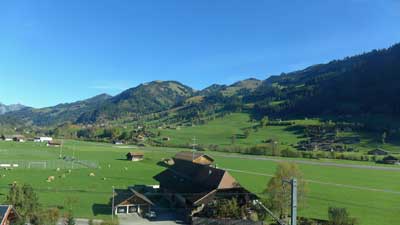
Geneva is a very famous city (though not for tourism reasons) on a lovely lake of the same name, but it’s also notoriously dull and lacking distinction. Rick Steves puts it well by saying that “Geneva is pleasantly situated on a lake, like Buffalo or Cleveland.” The point is, you don’t want to go to Geneva unless you’ve got something specific in mind that you want to see there.
Switzerland's cities in summary
Zurich – The largest city, very expensive, geared towards business travelers. It’s generally a pretty and very well-run city that you would enjoy if you visited, but it’s not nearly as interesting as the likes of Vienna, Munich, or of course Paris.
Geneva – Second largest city, in the French part of the country, no major sights. Again, if you visited you’d be very impressed by it and get some great photos, but it’s not worth your time unless you know someone there. There’s an impressive fountain in the lake and you can usually see it from the train as you go through the city, but it’s not really worth going there and staying more than an hour or so.
Basel – Bordering France and Germany, no major sights. It has the famous art market each year, and aside from that it’s even duller than the ones above. Again, if you visited you’d be impressed, but if you later compared photos with friends who went to the Lauterbrunnen Valley instead, you’d kick yourself for going to Basel.
Lausanne – Near Geneva in the French part of the country, very hilly, and certainly more interesting than Geneva.
Bern – The capital, compact, on a lovely river, some interesting sights and the best Swiss city to get a feel for the culture. Bern is fairly close to Interlaken (which we will discuss below) and it can be a great day trip from there, especially on a day where it is foggy and/or rainy in the mountains (and this happens a LOT).
How much time and which Swiss cities to visit?
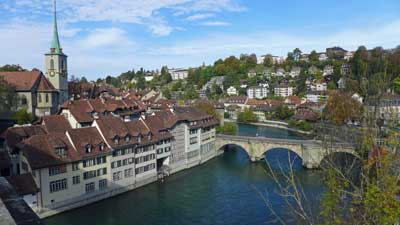
Many people (me included) don’t feel as if they’ve scratched the surface of a new country if they haven’t spent at least a day or two in the largest city. Zurich is certainly pleasant and a useful transit hub so spending one or two nights there wouldn’t be a major mistake. But Zurich isn’t even close to being a city like Paris, Rome, Berlin, Amsterdam, or even Vienna. If you skip it in favor of spending more time in the outdoors, you won’t be missing much.
The 2 Swiss places to focus on for short visits
Interlaken – If you want the best possible Alpine views and activities, head to the Interlaken area, which will be described in detail below.
Lucerne – The traditional Swiss tourist retreat, Lucerne is a small city with interesting culture and sights, that is gorgeously set on a lake with plenty of top activities surrounding it.
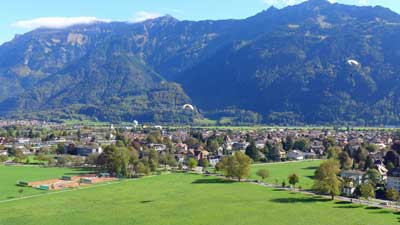
>>>Interlaken and Lucerne: Which to choose and how long to stay in each?
The article linked above will give you more details on which to choose and how long to spend in each place.
What about Zermatt for Alpine views?
Zermatt is a remote car-free village in southern Switzerland that is famous for being the place to see the Matterhorn mountain. It’s also a busy ski resort area, and aside from that, there isn’t much to see or do here. It’s on a private rail line, so it’s more complicated and usually more expensive to reach than Interlaken.
In other words, unless you’ve irrationally placed “Seeing the Matterhorn in person” on your so-called bucket list, skip Zermatt and head to Interlaken on a shorter visit. You won’t be sorry. If you already have enough time in your visit for the main sights around Interlaken and Lucerne and you want to also see the Matterhorn, then by all means go and you’ll enjoy it. There are quite a few other car-free villages in the Lauterbrunnen Valley near Interlaken, so they are not as novel in Switzerland as one might expect.
A weekend in Switzerland?
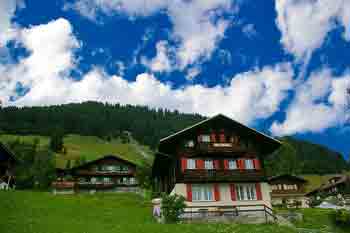
One challenge is that neither has an international airport so you’ll either be flying into Zurich or perhaps Geneva.
Train times from Zurich to Lucerne to Interlaken and back
- Zurich Airport to Lucerne: 1 hour 10 minutes by train
- Lucerne to Interlaken: 2 hours by train
- Interlaken to Zurich Airport: 2 hours 15 minutes by train
As you can see with the travel times above, Zurich Airport to Lucerne is a fairly short trip, but once you add Interlaken into the mix (even if you skip Lucerne) the travel time starts to add up for a weekend visit. With this in mind it’s probably best to just choose one of them and save the other one for another trip.
Lucerne is gorgeous, but the Lauterbrunnen Valley near Interlaken is really the star of the show, so I’d recommend going there first and doing Lucerne on another trip.
What about the Swiss Travel Pass?
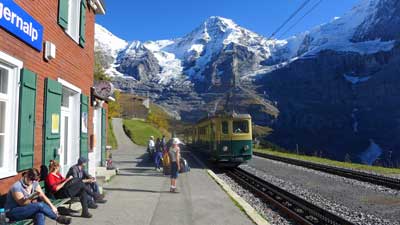
The bottom line is that if you are coming to Switzerland for at least 3 days and you want to take 2 or more of the amazing scenic rail journeys that the country is famous for, the travel pass is probably a good deal. It also provides 50% discounts on the Schilthorn cable car and 25% off the Jungfraujoch mountain railway. Both of those are quite expensive on their own, but extremely worthwhile, so the discount is helpful.
The Half Fare Card is probably a better deal for most people
The Swiss Travel Pass is a good deal for those who are going to be spending at least 2 or 3 days riding the rails and seeing Switzerland that way. But if you are mostly going to be focusing on Interlaken and Lucerne and the mountain sights, the Half Fare Card is the best option. For CHF120 (about US$134) you get the card that is good for 30 days and gives you a 50% discount on all trains, cable cars, mountain railways, and other sights and attractions. If you are doing either Schilthorn or Jungfraujoch, the Half Fare Card practically pays for itself with just one of those.
>>>Buy the Swiss Half Fare Card
Many people have questions about the Swiss Half Fare Card so I will explain it a bit here. You can actually buy half price train tickets for travel within Switzerland any time you want and you will see that option when you go to buy them online. The only thing is you have to have and present a valid Half Fare Card when you get on the train and are asked to see your ticket. In other words, you can buy a half fare train ticket today and buy a Half Fare Card just before you get on that train months in the future, and you are fine.
How and why visit the area around Interlaken
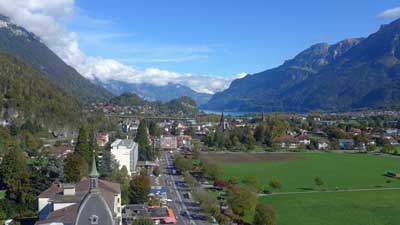
You can see everything discussed below by actually staying in a hotel in Interlaken, but it’s not the Alpine experience that you get if you stay in one of the small villages nearby. You can reach those villages in 20 to 40 minutes from the Interlaken Ost (East) train station, and it’s much easier than it sounds.
The 3 best places to stay to visit the Swiss Alps
Lauterbrunnen – A private train line runs from Interlaken Ost station to the end of its line in Lauterbrunnen. There’s a lovely waterfall here and great hiking trails, but you should probably only stay here if you can’t get to one of the villages mentioned just below. It’s a great little transit hub and it’s definitely gorgeous, so it can be worth a night if you’ve got one to spare.
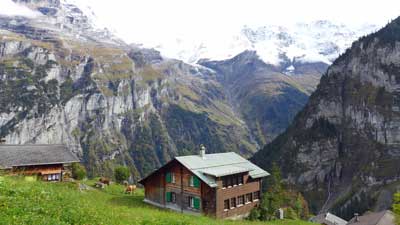
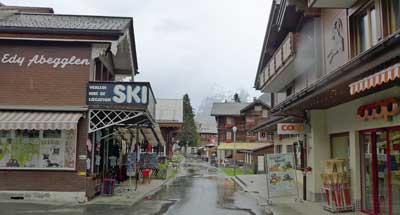
Where to stay in Interlaken and the Lauterbrunnen Valley (with pics)
I get so many questions about where to stay in the Interlaken area that I decided to write a longer version of it and load it with huge photos so readers can get a better feel for each option. I also included recommendations for affordable and well-located photos in each area.
>>>Where to stay in Interlaken and the Lauterbrunnen Valley New for 2024!
The unforgettable things to see here (if the weather is decent)
Schilthorn observation deck and restaurant
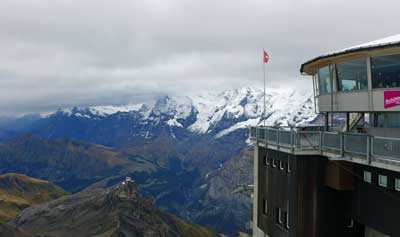
There is a rotating restaurant (with prices similar to normal Swiss restaurants) and a bizarre and anachronistic James Bond attraction based on it being a key location in the 1969 movie On Her Majesty’s Secret Service. The Bond thing is included with the lift, and it’s worth a look.
But the main thing you come here for is the 360-degree view from one of the highest peaks in Europe. Again, the weather here is key, but fortunately all the locals track the visibility on a minute-by-minute basis. If it’s clear up top while you are in the area, it would be a terrible shame to skip it based on the high price. But even if it’s cloudy up top, there are still plenty of wonderful things to see and do in the villages below.
Jungfraujoch observation area
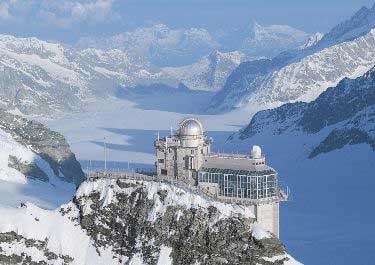
The views from the top are similar to the views from Schilthorn, from the other side of the Lauterbrunnen Valley. Once on top you can have lunch, hike, or even go sledding. It’s also quite expensive at nearly US$200 round-trip unless you have a Swiss Pass or a Eurail Pass for discounts, and it takes most of your day, but you’ll never forget the views from the top.
Harder Kulm mountain and Two Lakes Bridge Observation Deck
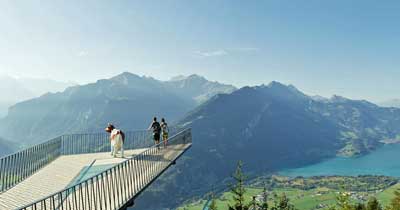
There’s a revolving restaurant about 10 minutes’ walk from the station at the top, which is definitely an unforgettable place for lunch if you’ve got time. It’s not as expensive as you might expect, at least compared to normal restaurants in Switzerland.
The Harder Kulm Railway goes from early April through late November each year. If you are only in Interlaken for one day and/or you are on a strict budget, this is the fastest and best way to get amazing Alpine views in the area.
Getting from Interlaken to Gimmelwald and Mürren
Getting up to these villages sounds complicated and time consuming, but it’s actually fast and easy once you get there. This little guide should help.
Arrive in Interlaken
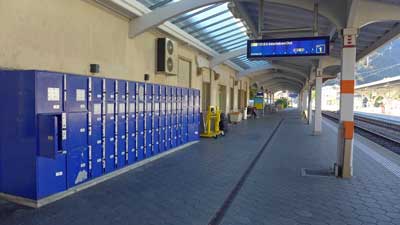
Once you arrive at the Interlaken Ost train station, head for the ticket windows in the office and buy a ticket to your final destination (Lauterbrunnen, Gimmelwald, or Mürren). Eurail passes are good for 25% discounts on the rest of the trip, but not for the whole thing.
From Interlaken Ost to Lauterbrunnen
The private train leaves Interlaken Ost every 30 minutes and arrives in Lauterbrunnen 20 minutes later. If you are staying in Lauterbrunnen then you are probably walking distance from your hotel when you reach the station.
From Lauterbrunnen to Gimmelwald
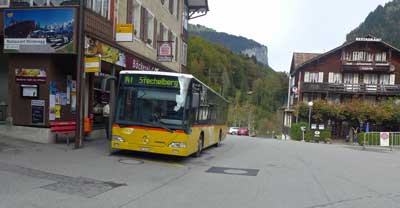
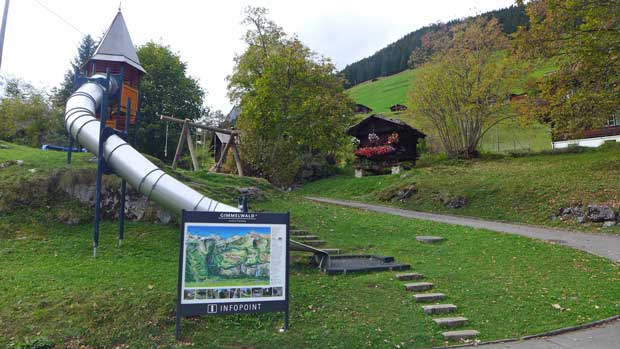
From
Gimmelwald to Mürren
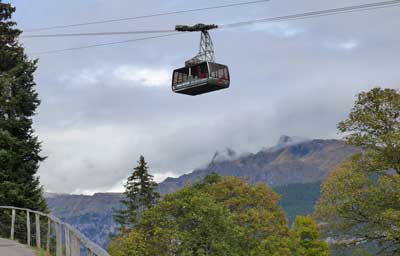
Recommended hotel and hostel in Gimmelwald
I get asked all the time about where to stay in Gimmelwald, so here it is:
Hotel: Esther’s Guesthouse
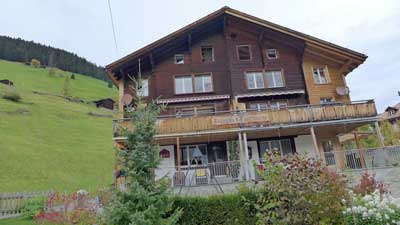
It’s run by Esther, as you might guess, and she is very friendly speaking excellent English. Each room is different and the place feels like a mountain cabin, because it is. She offers an excellent buffet breakfast in the morning, which you have to order the night before. It’s not cheap, but it’s worth it because it’s hearty and there are no other good options nearby.
Book as early as possible because this place is often the first place to sell out in Gimmelwald.
Hostel: Mountain Hostel Gimmelwald
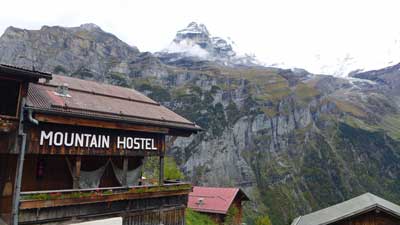
You won’t believe the views from this place, which are the same as from Esther’s except a bit lower and more unobstructed. This place also has a busy bar and restaurant that is basically the only “nightlife” in Gimmelwald. Many hikers get to bed early in this tiny village, but if you want to have a couple drinks and order a pizza or some local options, this is the place to go.
Again, book early because this place is always sold out.
Lucerne and what to do there
Luzern, as it’s spelled locally, is the other traditional holiday destination in Switzerland. Unlike Interlaken, Lucerne actually qualifies as a small city rather than a small resort town, so it’s a very nice contrast and very worthwhile.
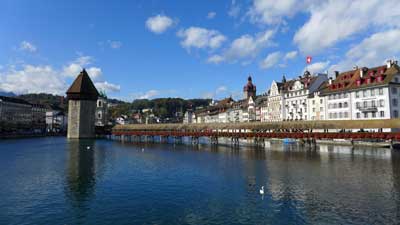
However, unlike Interlaken, the town of Lucerne itself is a great attraction and worth at least a day of exploration. This has always been a rich area so you can expect to find all of the high-end shops and boutiques along the small streets just north of the lake, but there are also many traditional shops and things to see that will appeal to anyone.
Recommended hotel in Lucerne
>>Hotel Des Alpes (3 stars with an amazing location and view)
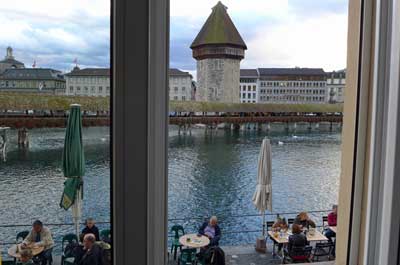
If this place is booked, which is often the case, then book a hotel as close to it as you can find or afford. The whole historic part of town surrounding it is lovely, with restaurants, bars, and high-end shops. There are also a couple of nearby supermarkets where you can buy inexpensive alcohol and picnic supplies to keep other costs down.
Spend a day in Lucerne itself
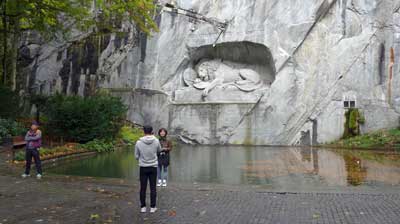
Most of the interesting part of Lucerne is in the area behind those restaurants, and it’s certainly worth doing a self-guided walking tour if not a guided one. Heading farther east you’ll come to another older part of town where the famous lion statue is located. You can’t visit Lucerne without having a look at the lion, and fortunately it’s easy and quick to reach (and it’s free).
Take a lake cruise of some kind
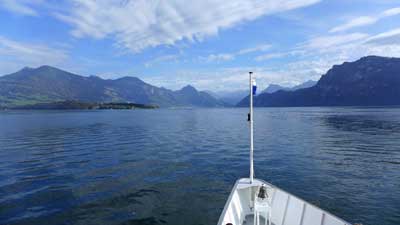
Especially in nice weather, even the short lake tour is lovely, and if you have more time you can jump off at Vitznau and do the scenic hike up Mount Rigi. There are also small lakeside villages that are ideal for a stroll and lunch stop. Long story short, there are dozens of interesting sightseeing options that are available using part of the boat tour, and the views all around are wonderful.
Visit Mount Pilatus
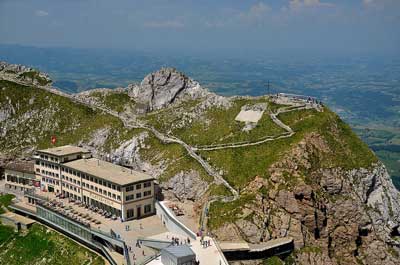
You can take the cogwheel train up and have a more or less flat hike around the summit area, and then take the gondola and cable car back down again. You can do them in the other order, and the cost is the same either way. At around US$65, this is not a cheap hike, but like most everything in Switzerland, the quality is high so it doesn’t feel like a rip-off. You can reach the cable car in 10 minutes on a public trolly bus from Lucerne.
Visit Mount Rigi
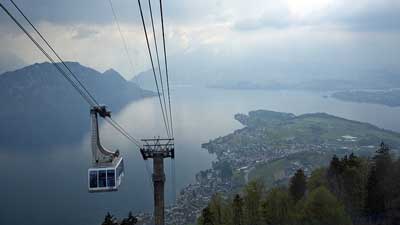
Unlike the other peaks mentioned in this article the Swiss Travel Pass covers both ways to get up and down for free. The others are 50% off with the Swiss Travel Pass or Half Fare Card, except for Jungfraujoch, which is only 25% off with the Swiss Travel Pass and still 50% off with the Half Fare Card.
Visit Mount Titlis
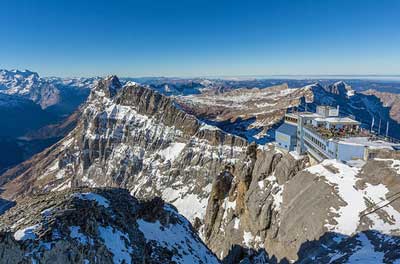
You can reach Titlis by taking a 43-minute train ride from Lucerne to Engelburg and then taking the cable car up from there. As with the others, it’s wise to check the weather immediately before you are going to depart because it can be foggy or cloudy any time of the year, but usually not for whole days at a time.
Additional photo credits
Jungfraujoch by cupweuro on Flickr, Pilatus by Tony Fernandez on Flickr, Rigi by Kosala Bandara on Flickr, Titlis by PaulSchliebs on Flickr

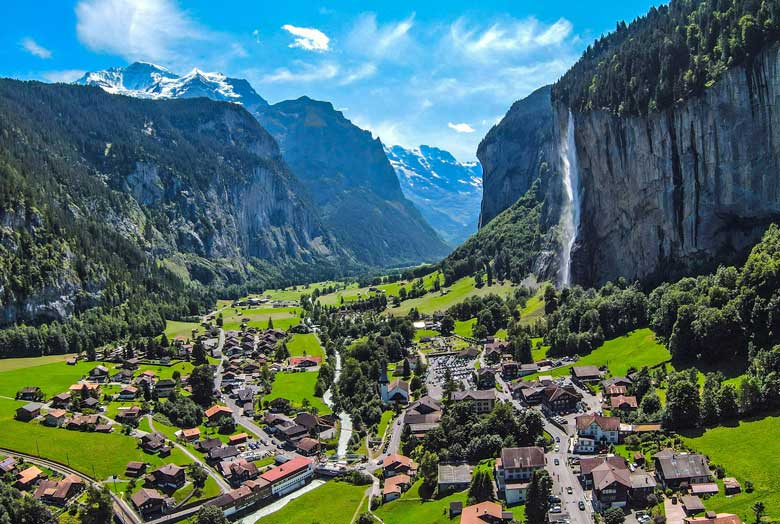
I understand that a cable car car takes one to Gimmelwald from Stechelberg. Could you tell me how much does the cable card ride to Gimmelwald cost?> Is there a website that shows this?
JUDHAJIT,
I’m also having trouble finding that price online, but it’s around CHF5 or so. When I was at the Interlaken Ost train station I bought a combined ticket for the train to Lauterbrunnen, the short bus ride from across from that train station to Stechelberg, and the first leg of the cable car up to Gimmelwald. I think that was CHF17 for the three legs, one-way. And I think it costs about CHF5 to go from Gimmelwald to Murren or back. The next leg of the cable car is also fairly short, and it’s used by local residents so the price is also reasonable. It’s only that long final leg up to Schilthorn that costs so much, and that is because it also includes admission to the observation deck building and the James Bond attraction. It’s worth it though, as long as the weather is fairly clear up top.
In other words, most Swiss cable cars are used by locals and hikers, and the prices are similar to expensive local buses. I’d guess that they are all under US$10 or so. But the Schilthorn itself is quite expensive, justifiably so. -Roger
Is there a convenient way to travel overnight from Interlaken to Paris? I do not see any train connections. Is there a bus service? Are the views on the route very good which will make a day trip worth it.
Thanks
JUDHAJIT,
There are night trains from Interlaken to Paris that take about 11 hours, but they aren’t convenient because you have to change trains twice or more in the middle of the night. I would not recommend it. The day trains take 5 to 6 hours with one change in Basel, and the scenery in Switzerland is very nice, but once you get into France it’s mostly rolling hills that all look alike after a while. It’s too much traveling to go there and back in one day, but if you can spend one or more nights in Paris it could be worthwhile.
There probably are buses, but they would take around 10 hours or more. The trains in that part of Europe are all high-speed on these main lines, so they are much faster than buses. -Roger
Thanks again for the detailed replies.
Another question comes to my mind.
During Jungfrau excursion, I would like to get down at one/more villages en route for a walk around. Which villages (Wengen, Lauterbrunnen, Grindelwald, Kliene) should I consider? Will it be a wise thing to go up without making any stops and keeping the village visits for the return trip.
Regards
JUDHAJIT,
Of the ones you listed, I think Wengen is the most charming of them and the best one to stroll around a bit in. If you do the hike above Wengen, which is one of the best, you’ll walk through the small town on your way from the train station to the cable car station. Just going to the places you are already planning, you’ll get plenty of chances to see the sort of Swiss villages and towns that are like these, so you won’t miss it even if you tried. -Roger
Hi Roger,
A couple of more questions:
What kind of weather could I expect in the first half of October?
I am super confused about Rigi. I am already getting Alps views from the Jungfrau (weather permitting) and a mountain railway ride as well. Do you consider as a must-do?
Thanks
JUDHAIT,
You can get better weather information on weather sites or wikipedia for each city. But I can tell you that it should be pleasant and fairly warm in the valleys in October, and it’s always fairly chilly up in the mountains, so it’s important to dress in layers. There won’t be snow in Gimmelwald or Murren that time of year, but it’s there year round on the peaks.
As for Rigi, I skipped it myself for the same reason. Also, each of those cable cars are kind of expensive, so you do want to choose them wisely. On the other hand, Rigi is popular for a reason and those who do the trip seem to really like it, so I don’t think you’d regret it if you went up. I’d just go on the cruise and decide when you get there. -Roger
Hi Roger,
Many thanks for your detailed reply.
We will be reaching Zurich at around 6.30 in the morning, which means we should be in Lucerne by 9.00-9.30 a.m., with some time included for refreshments. That means we will have the whole day to see Lucerne. Instead of staying over at Lucerne on Day 1, I was considering putting our luggage in railway locker, do a boat ride and walk around in Lucerne and then push off to Interlaken later in the day. In that way we get 3 whole days in Interlaken. Do you think this will be too hectic for the day of arrival? Also do you think its worth spending an evening in Lucern?
After I reach Interlaken on Day 2, I plan to go off on a day tour to Bern. Since Bern can be seen in a few hours, should I consider covering some other place as well?
Do I need to book the train tickets in advance? Or in other words are the train tickets in Switzerland dynamically priced?
I think Swiss half fare card suits me the best. I understand that the cards can be purchased from the airport on arrival. Is my understanding correct?
Do you think lake cruises in Lucerne and then in Brienz and Thun will be repetitive?
Do you think it is worthwhile to keep one full day for exploring Lake Brienz and Thun and the lakeside towns and villages around it?
Many questions asked …. Waiting for your reply.
Thanks again.
JUDHAJIT,
As I mentioned in my original reply, I would stay in Lucerne for one night because it’s very nice. You can read the rest of my remarks in the other reply.
Spending half a day on a Bern day trip would be worthwhile. Aside from that, there are many great sights and things to do in and around Interlaken, so I wouldn’t recommend any other trips.
Train tickets within Switzerland are a fixed price, so you can buy them when you arrive or just before each journey. Some of the most popular morning or afternoon trains might sell out once in a while, but that is probably rare.
I’m not sure where you buy the Swiss Pass if you don’t buy it online. I’m sure it’s on the official site though.
As for the lake cruises, the ones in Lucerne are the most popular, but the scenery is quite different around Interlaken so I don’t think those would be repetitive. It’ll be best to decide on those once you get there. You might be in the mood to do all of them, or maybe not.
The real magic of the Interlaken area are the Alpine views and peaks and hikes. I’d focus more on that, and probably less on the lakes. -Roger
Hi Roger
Good evening.
We are planing to Swiss from Italy(Venice) for 6 days 5 nights visit in mid sep’16.
We hope to cover places like Interlakaken, Lucern, Jungfraujoch and possibly Bern too.
Would you please advise how shall we plan the above places?
(Including the Swiss passes advise, possibly..)
Hopefully, we could have a chance try on ice-skiing as well… 🙂
Thanks in advance.
Regards
Amie
AMIE,
I’m not sure exactly what you are asking, but I’ll give it a try.
I’d recommend 2 nights in Lucerne and 3 nights in the Interlaken area. If you want to visit Bern, you can get there in 48 minutes by train from the Interlaken West train station, so you can do it as a day trip. The main sights in Bern are all within a short walk from the train station there, so you can have a great visit in 3 or 4 hours, so you can really do it all in half a day.
Swiss Travel Passes are confusing and they are generally only good for people who want to travel on the private railways (like Jungfraujoch) and many cable cars (at half price) that are included. It’s hard for me to recommend them without knowing all of the things you plan on doing. And if you know all of the things you are going to want to do, you can probably tell yourself whether a Swiss Pass will be good value or not.
The main ski season in Switzerland runs from December through March or April, so you probably won’t have a chance. There is snow all year round on the highest peaks in the area, but the ski runs are well below those, so they only operate in the winter season.
If you have more specific questions, feel free to ask them. -Roger
Hi Roger,
My wife and me will be doing our first Eurotrip during October 1-12 (Central Swiss 4 nights, Paris 4 nights, Amsterdam 3 nights). I need your comments on the itinerary I have planned:
Day 1: Arrival in Zurich morning; Take train to Lucerne, spend the day in Lucerne, boat ride in lake lucerne, see main sights; stay at Lucerne
Day 2: Lucerne – Interlaken by morning train; check in at hotel; travel to Berne for half-day outing; night at Interlaken
Day 3: Visit Jungfraujoch; visit Gimmelwald during return from Jungrfrau; stay in Interlaken
Day 4: Take cruises on Lake Thun & Brienz and explore lake side villages/towns such as Speiz, Thun etc. by foot; stay in Interlaken
Day 4; Train from Interlaken to Paris
Some specific questions:
Is it worth stretching ourselves to do Rigi on the first day or we should do just lake cruise and explore Lucerne on foot?
Should we just stop over at Lucerne, put our luggage in railway locker, take a boat ride and walk in Lucern and push off to Interlaken on Day 1
Is it economical to stay in Gimmelwald/Lauterbrunnen with our plans to explore lakes in Interlaken?
How would you rate Lauterbrunnen against Gimmelwald?
Which place is cheapest in Interlaken area for stay?
How much money should I budget for food per head per day?
Are there lockers in train stations? What are their rates and safety?
Thanks Judhajit
Judhajit,
Your itinerary looks really well researched and organized. I think you’d have a fantastic time if you did exactly as you’ve written out. And I’ll take a shot at your questions in order…
The train from Zurich Airport to Lucerne takes a bit over an hour, and if you can get to Lucerne by 1pm or so, then you’ll have time to go up Rigi if you like. Basically, when you get there you will buy a ticket on the lake cruise boats that stop at 5 or 6 nearby cities over the course of a 2-hour trip. One of those stops is the base of Rigi, and if you get there early enough you can get off the boat and spend 2 or 3 hours going up and down, and then get back on the next boat back to Lucerne. If you don’t get there early enough, just stay on the boat and enjoy the lake views.
I’d spend at least one night in Lucerne. The Interlaken area is more spectacular, but the town of Lucerne is really lovely as well, especially if you can get one of the hotels that overlooks the part of the lake with the famous wooden bridge.
Deciding exactly where to stay in the Interlaken area is a bit tough. There are advantages and disadvantages to each place. If you stay in the main town of Interlaken, you are close to the train stations and you have scores of restaurants and activities to choose from, but you don’t feel the “magic” of the Alps from the base. In Lauterbrunnen you are in a gorgeous valley at the base of some dramatic mountains, and you are between Interlaken and the best peaks, but you still aren’t really “in the Alps”. Gimmelwald and Murren are 5 and 10 minutes up the mountain by a cable car that goes every 30 minutes all day and evening from Lauterbrunnen, and as long as the weather is decent they are among the most scenic mountain towns in the entire world. But of course, it does take 30 to 60 minutes getting in and out each time, so they aren’t as convenient as the others. As far as I can tell, hotel prices are in a similar range in all of them, with more bargains available in the town of Interlaken itself.
On my most recent trip I stayed at Esther’s Guesthouse in Gimmelwald, and on my next trip I’ll probably do exactly the same thing. If Gimmelwald was booked up I’d look for a place in Murren. To me, it’s worth the extra time and small expense to stay up the mountain rather than in Lauterbrunnen or Interlaken.
I also stayed at a hotel a few blocks from the Interlaken Ost (east) train station, and hotel rates in that area do seem to be the lowest in the area. Most things (particularly restaurant meals) in Switzerland can feel shockingly expensive at first, even compared to Germany and France nearby. So you have to just think of this as a worthwhile splurge for a few days because you’ll see that it is very worthwhile. In other words, you can probably find a cheaper hotel if you are willing to go to an inconvenient location in another nearby town, but I wouldn’t recommend it.
As for food costs, breakfast will run at least US$10, even for something simple. For lunch you can get a sandwich or doner or take away from an Indian place for around US$10 up to maybe US$15. When you go to a sit-down restaurant for lunch or dinner, a main course will cost between US$20 and US$25 at even the cheapest restaurants, not including a drink. But you will have several good choices within that range.
Yes, there are lockers at all of the train stations you’ll be using in Switzerland. I’d guess that the rates are around US$5 to US$10 for 4 hours or so, but I’m not sure. And they are very safe, just like everything else in Switzerland. -Roger
Hi Roger,
your write up about Swiss travel is excellent….i changed my entire plan and schedule based on this, coz this is exactly how we would love to explore switzerland.
My husband and i, along with our 2.5 year old were planning to travel in june…however we hate to travel when its touristy…and would love to travel when its an off tourist season…on reading up came across that September is not so crowded. so we were planning September. is that a good time?…
We are more of a place and food explorer kind of travellers…
Your input would really help us plan.
Thanks.
Yesha.
Your
Yesha,
I’m happy to hear that my article was helpful, and I’m confident that you’ll really enjoy visiting the places that I’ve recommended. As for when to go, I think September will be excellent, although only a bit less crowded than June. The thing is, many Europeans take either all of July or all of August off work, but most of them head to beaches and lakes and such. Some do obviously head to Switzerland as well, so those are the two busiest months of summer.
Beyond July and August, June and September will be pretty similar in visitor numbers, so I think you’d be just as happy in either month. Fortunately, the main Swiss attractions such as the Alps and Lucerne are places that aren’t suited to day trips, so visitor numbers don’t really exceed the number of nearby hotel rooms. In other words, hotel availability helps spread the crowds out so it’s never overwhelming. This means it’s different from places like Venice or Dubrovnik, which get filled up each day with people on bus tours and cruise ships as well.
To make a long story only a bit longer, I think if you can find affordable hotel rooms in the areas you want to visit, the crowds won’t feel too large or unruly. Have a great trip and let me know if you have any other questions. -Roger
Hey thanks a lot roger!… your quick response is much appreciated! 🙂
Hi Roger.
I was lucky enough to llive in Switzerland for a few years and agree with all of your recommendations. Friends who visited us couldn’t understand why we tried to steer them away from Geneva and Zurich. I am returning for a visit this June and am wondering what your suggestion would be for visiting the Italian region of CH. I am staying with friends near Geneva and we’d love to get away for two nights down South. Thanks.
Diana,
I’m always happy to hear that my advice makes sense even to those who have spent far more time or lived in these places. It’s funny about Geneva because it’s such a famous city (although mainly for hosting international organizations) on a famous and gorgeous lake, that it’s easy to assume that you should spend a lot of time there. It’s the same thing with Zurich, as I’m also guilty of mainly visiting a country’s largest city on my first and often only visit.
Unfortunately I’ve spent very little time in the Italian corner of Switzerland so it’s hard for me to make recommendations with confidence. I can confirm that Lugano is the primary tourism town in that area, and is almost certainly where you want to stay. I was going to stop there on my way to nearby Lake Como, but the connections were slow so I ended up going a different way to save time. Have a great trip and thanks for the kind words. -Roger
Hello
I have June 27-June 30 open and will be traveling from Helsinki to Swtizerland. From Switzerland I need to be in Berlin by the 30th. I am trying to determine the best airport to fly to and out of. Would like to take your advice of visiting Lucerne and then travel to Interlaken, I just want to be certain I am back to an airport in time for the flight to Berlin as I am meeting people in Berlin…can you provide an estimate on travel time? maybe a night train to the airport on the 29th or 30th? IS there a train from lucern to Germany maybe?
I need to read more, sorry if you have answered similar questions in your posts already…I will go through them as well.
Thank you
Mary,
Zurich Airport is your best option, and airfares there are surprisingly affordable considering how expensive the rest of the country is. Geneva Airport is also a possibility, but it’s farther from Lucerne and Interlaken both.
The good news is that Interlaken to Zurich Airport takes a bit over 2 hours, and Lucerne to Zurich Airport takes about an hour, with trains starting around 5am. The trains go directly to the airport train station on the main route, and they are famously punctual. Also, the train fares for journeys within Switzerland are the same no matter when you buy, so you can buy them the day before you want to leave and the price will be the same, and fairly reasonable.
A train from Lucerne all the way to Berlin will take a bit over 9 hours. Most of it isn’t very scenic, and it will almost certainly cost more than a flight, so I think flying from Zurich to Berlin is the way to do it. Have a great trip. -Roger
Thank you so very much for your response…your timely replies are so appreciated!
Regards,
Mary